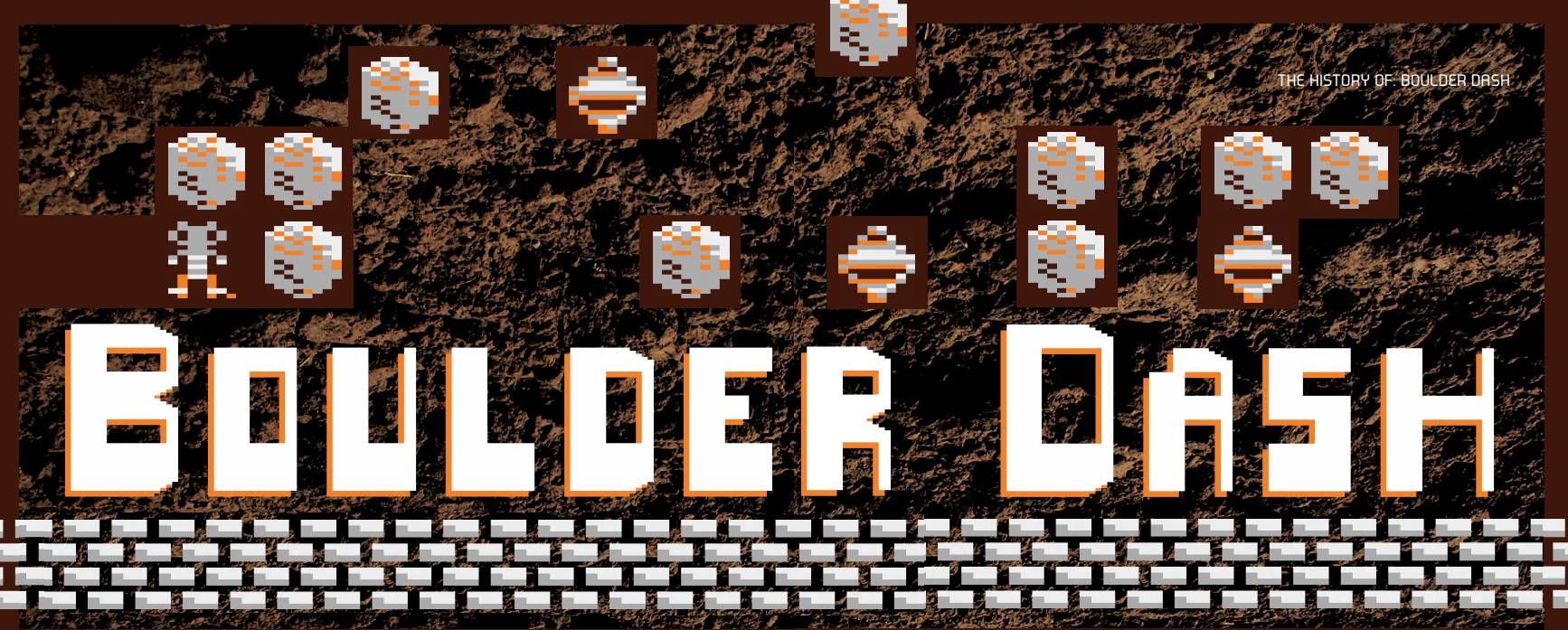
Created by two Canadian programmers, Boulder Dash® has become one of the longest running videogame franchises thanks to publisher First Star Software. Mike Bevan looks at the history of a foot-tapping fella named Rockford and his various appearances through the years
Determinism. It’s a rather philosophical term to use when discussing a videogame, but it’s a word that crops up several times when talking to Chris Gray and Peter Liepa, the co-creators of Boulder Dash. In a game involving retrieving diamonds and avoiding falling rocks, players make dozens of split-second decisions which affect elements of their cave environment, with a multitude of possible outcomes and ways to play through each level. It’s the beauty of a well-loved franchise that has stood the test of time and is about to celebrate its 30th anniversary, with a rather nice little surprise for fans just around the corner …
“The original inspiration came about probably in the middle of 1982,” recalls Chris Gray. “I would have been aged 14, and we had an Atari 2600 at home and eventually that led to the family getting an Atari home computer with a tape drive. Over that year I just went crazy just playing with gameplay mechanics and learning how to write games based on things that I played or were inspiring me, and I was sharing them with friends and getting more and more proficient at it.”
Although there were several games in the arcades around the time involving tunnelling through earth, notably Namco’s Dig Dug and Universal’s Mr Do!, it was a less well-known coin-op that provided the creative spark for Chris. “Dig Dug would probably have been a year or so later,” he confirms, “but there was another game called The Pit which inspired me to do something along those lines, but with rocks that had more behaviour. The original prototype was written in BASIC, and The Pit was the thing that got me thinking about the rocks, then I wrote algorithms to make the rocks fall and roll and shake, and just generally behave in a more interesting way.”

“Around that time I’d also been dealing with a company in Mississauga, just outside Toronto. When I was a teenager I’d go into Toronto and there was a chain of stores called Electronic Playworld and I would go in and try and see the latest games because we didn’t even have a floppy drive at home… So I’d get a great thrill of being in the city and playing the games and visiting arcades, and I got to know the owners and I found out they also had a company called Inhome Software, which was doing Atari 400/800 cartridge games. “
“I had gone to them with the original idea for what became Boulder Dash, and at that point it was still in BASIC, so we were looking for a way to take it to the next level. They had a network of people they had been working with and Peter Liepa had approached them about making games, and they said ‘We’ve got this person with this concept and we’d like to make it more marketable so it would have to be in assembly language if it was going to be an Atari cartridge game.’ And we were introduced and it kind of went from there.”
“Peter started by taking what I had done in BASIC and creating a more elaborate algorithm in assembly language,” says Chris. “This was before the game even scrolled. The original version didn’t have any scrolling – Peter added that later.” Twice Chris’s age at the time, Peter was a maths graduate with an interest and background in physics, ideal qualities for programming a game with a reliance on falling boulders and a dynamic environment. But he admits that initially he was a little sceptical, fi nding the prototype’s gameplay a little too “predetermined”, only to be won over on realising the potential of the Chris’s idea. “I started playing with basic elements of dirt, rocks and jewels and within a couple of days had built the basic ‘physics engine’ of what was to become Boulder Dash,” says Peter. “I realised that using a random number generator you could generate random caves, and that by controlling the density of rocks and jewels you could get some interesting gameplay.”
“Producing levels was surprisingly easy”
Peter Liepa
It was with the idea of using a degree of randomisation to generate the caves that Peter stumbled on the key to creating a captivating and diverse mix of action and puzzle-elements. “The physics were sufficiently rich that producing levels was surprisingly easy,” he says. It’s funny how that works… each time you shuffle a deck of cards you get a new hand of solitaire, poker or bridge. I’m a fan of indoor rock climbing, and I’m fascinated by the endless varieties of routes you can generate by placing holds on a wall. In Boulder Dash, the rocks, diamonds and dirt were mostly placed with random number generators. The puzzles of navigating these mostly generated themselves. The other non-random elements – like walls and exits – were there to mainly to give some focus or sequence to the puzzles.” And what puzzles they were, including funnelling rocks through magic walls to transform them into jewels, dropping boulders onto fireflies to blast through barriers and unleashing swarms of butterflies on an expanding ameoba, creating a chain-reaction of explosively incarnated diamonds.
![[Atari 8-bit] The first cave from Peter’s original Atari 8-bit version of Boulder Dash](https://boulder-dash.com/wp-content/uploads/2019/06/history1.jpg)
At the game’s core was the insect-like hero of Boulder Dash – Rockford. “My early versions of the game used 8×8 pixel elements to represent a stick figure, dirt, rocks and jewels,” says Peter. “Our early would-be publisher thought this was not engaging enough, and that ‘the man’ should be larger and more identifiable. So I ended up doubling the size of everything to 16×16 pixels and giving ‘the man’ a more recognisable look and some animations [including his charismatic blinking and footstamping]. It was First Star who eventually gave him the name Rockford.”
“I just so happen to be the person that opened the envelope containing the floppy disc that Peter Liepa had submitted to First Star Software,” reveals Richard Spitalny, co-founder and president of the company that has overseen every Boulder Dash game for three decades. “I booted the game myself and was hooked immediately. I remember that I did that while I was rushing to leave the offices and I could only spend a minute or two to take a quick look to see if it was something I would pass on to have reviewed. I was able to get into th
e game easily and quickly because it was so simple and intuitive. I enjoyed the unique challenges, the ’mental gymnastics’, of the caves coupled with the hand-eye and quick reflexes needed to avoid falling boulders and enemies. It was like nothing I had ever played. Needless to say, I was late to my appointment!
![» [C64] The ingenious ‘funnel’ cave had you pouring rocks through a magic wall to create diamonds](https://boulder-dash.com/wp-content/uploads/2019/06/history2.jpg)
“What Peter submitted to us was fairly close to the finished game. We asked for additional colour palettes and we came up with the idea of inserting non-scrolling caves as bonus puzzles. Players would still advance to the next cave, even if they didn’t conquer the bonus cave … they simply provided a way to earn additional points and to break up the gameplay a bit. We worked a lot with Peter in setting the difficulty ramping. We all knew that it was very important to introduce new elements slowly and carefully. It was a delicate balance in terms of challenging players without frustrating them, which is why you could skip ahead every fourth cave. In addition to the underlying core elements and cave designs, which Peter implemented brilliantly, I really liked the ability to push, grab and dig without moving. I also really liked what the amoeba added to the game, as well as the explosions of fireflies and butterflies. I would say that Cave M is my favourite cave in the original game.
THE BRITISH CONNECTION
The Pit, Chris’s inspiration for Boulder Dash – made in sunny Blighty!
 As Chris has confirmed in our interview, the inspiration for what became the original Boulder Dash stemmed from an arcade game called The Pit, released by Florida-based arcade manufacturer Centuri in 1981. The single screen coin-op title featured many elements that he integrated into his Atari prototype – levels are completed by grabbing the required amount of diamonds and you can dig under and dislodge rocks to block or trap chasing enemies, although you can’t destroy them by dropping boulders on them. Regular RG readers might be aware that The Pit was designed by UK-based company AWL Electronics, headed by Andy Walker, later supremo of C64-centric software house Taskset. This is a fact that Chris is surprised and delighted to be told. “I never knew that,” he exclaims. “I was quite young and just sucking up the world of games like a sponge at that point – my father was British and a corporate lawyer and he helped me try and understand the need for putting together contracts for Boulder Dash!” We thought it might be fun to report how AWL’s game inspired Rockford’s first outing to the man himself. “That’s really heartening,” says a flattered Andy. “I honestly never heard from Chris before, and it’s a most agreeable confirmation. Please send him my best regards and guarantee of a fine cask of ale on his next Yorkshire visit… he’s been through those long hours of development and he got published!”
As Chris has confirmed in our interview, the inspiration for what became the original Boulder Dash stemmed from an arcade game called The Pit, released by Florida-based arcade manufacturer Centuri in 1981. The single screen coin-op title featured many elements that he integrated into his Atari prototype – levels are completed by grabbing the required amount of diamonds and you can dig under and dislodge rocks to block or trap chasing enemies, although you can’t destroy them by dropping boulders on them. Regular RG readers might be aware that The Pit was designed by UK-based company AWL Electronics, headed by Andy Walker, later supremo of C64-centric software house Taskset. This is a fact that Chris is surprised and delighted to be told. “I never knew that,” he exclaims. “I was quite young and just sucking up the world of games like a sponge at that point – my father was British and a corporate lawyer and he helped me try and understand the need for putting together contracts for Boulder Dash!” We thought it might be fun to report how AWL’s game inspired Rockford’s first outing to the man himself. “That’s really heartening,” says a flattered Andy. “I honestly never heard from Chris before, and it’s a most agreeable confirmation. Please send him my best regards and guarantee of a fine cask of ale on his next Yorkshire visit… he’s been through those long hours of development and he got published!”
![[Spectrum] This cave provided multiple ways to get Rockford accidentally trapped…](https://boulder-dash.com/wp-content/uploads/2019/06/history4.jpg)
“I was very confident that the game was going to be a hit as soon as I played it”
Richard Spitalny
“I was very confident that the game was going to be a hit as soon as I played it… even before it was the final game. But I had no idea it would be so phenomenally successful. Our very good friends, the much missed Bill Kunkel and Arnie Katz, founders and editors of Electronic Games magazine, fell in love with Boulder Dash the moment they first saw it. Their initial review as well as many others from all of the leading magazines of the day contributed to the game’s success. OMNI magazine named it number three in their ‘Ten Best Video/Computer Games’; Family Computing selected it as ‘Arcade Game Of The Year’; Personal Computer named Boulder Dash ‘Game Of The Year’ and Computer Entertainer selected it as their ‘Atari Computer Program Of The Year’. A Commodore 64 magazine in Europe named Zzap!, with our permission, adopted Rockford as their mascot and would draw him in the margins of random pages in every issue for years and years!” “It was very important to build on the momentum achieved with the Atari version and port to Commodore 64 and Apple II, and to license the game internationally so that it was supported on numerous platforms not found in North America,” asserts Richard. “It quickly became a huge success in Europe and Japan.” The huge impact of the game quickly led to a sequel also designed by Peter – Boulder Dash II: Rockford’s Revenge. The game introduced a couple of new elements – walls that expanded horizontally when earth was dug out around them and a blue slime that slowed falling diamonds and rocks for a short time. “Boulder Dash II was a pleasure to produce, because most of the hard work had already been done, so all of the effort could go into producing more novel caves,” says Peter. “I didn’t produce any versions after that, although I was called in for a couple of days to create caves for a later sequel, Rockford.”
While Boulder Dash II was well received, the third instalment of the franchise was seen as a bit of a let-down, due to its ill-advised ‘space’-themed visuals and the fact some levels were buggy and impossible to complete. “Boulder Dash III was developed and released by [Swedish company] American Action and it was somehow brought to our attention before it was released,” comments Richard. “We made the mistake of letting them release the game in exchange for a royalty advance, rather than shutting them down and keeping the game out of the market. Obviously that was not the best thing to do for the brand. But I think everyone would agree that in the long run it didn’t matter that much and hasn’t really hurt the brand over time…”
![[C64] The butterflies versus ameoba encounter in Cave M is a true Boulder Dash classic.](https://boulder-dash.com/wp-content/uploads/2019/06/history5.jpg) After this minor setback for Rockford, First Star bounced back with a unique gift for fans with an opportunity to create their own levels with Boulder Dash Construction Kit. But, we ask Richard, after the enormous popularity of the first two games wasn’t this a case of killing the golden goose, so to speak?
After this minor setback for Rockford, First Star bounced back with a unique gift for fans with an opportunity to create their own levels with Boulder Dash Construction Kit. But, we ask Richard, after the enormous popularity of the first two games wasn’t this a case of killing the golden goose, so to speak?
“There was a lot of debate about whether or not to develop and release an editor which would let everybody and anybody design their own Boulder Dash caves,” he confesses. “At the time, I don’t think that we were looking out into the future as much as one might’ve expected. We were also very much focused on the Spy Vs Spy games and it was not very easy for people to exchange caves with each other back then like it is now.”
![» [C64] Boulder Dash III’s space setting was rather controversial.](https://boulder-dash.com/wp-content/uploads/2019/06/history6.jpg) Richard is also eager to discuss Rockford’s various arcade ventures, starting with a version of the original game manufactured for arcades by Exidy. “Working with Exidy on having Boulder Dash released into the coin-operated arcades was incredible,” he says. “It was very exciting and I don’t believe that any home computer game had been brought from the home into the arcades before that. At that time, games were always released in the arcades first and, if they did very well, then they were ported for home computers or video game consoles. Of course, what Exidy did was to house Atari computers inside coin-operated arcade cabinets. However, the two arcade games developed with Data East were real arcade games. Data East also published the NES version in Japan, while JVC published the Game Boy and NES versions in North America, with Nintendo publishing those versions in Europe. Rockford, for Arcadia/ Mastertronic, was the other arcade version of Boulder Dash. We developed the game on the Amiga and it too was housed in an arcade cabinet.”
Richard is also eager to discuss Rockford’s various arcade ventures, starting with a version of the original game manufactured for arcades by Exidy. “Working with Exidy on having Boulder Dash released into the coin-operated arcades was incredible,” he says. “It was very exciting and I don’t believe that any home computer game had been brought from the home into the arcades before that. At that time, games were always released in the arcades first and, if they did very well, then they were ported for home computers or video game consoles. Of course, what Exidy did was to house Atari computers inside coin-operated arcade cabinets. However, the two arcade games developed with Data East were real arcade games. Data East also published the NES version in Japan, while JVC published the Game Boy and NES versions in North America, with Nintendo publishing those versions in Europe. Rockford, for Arcadia/ Mastertronic, was the other arcade version of Boulder Dash. We developed the game on the Amiga and it too was housed in an arcade cabinet.”
![[Atari 8-bit] Getting to these diamonds means Rockford must run a gauntlet of fireflies](https://boulder-dash.com/wp-content/uploads/2019/06/history7.jpg)
“You can always find traces of the original Rockford in every Boulder Dash”
Richard Spitalny
The two Data East arcade releases are particularly charming, especially Boulder Dash Part 2, which features cute Japanese style graphics with Rockford wearing a mining hat, themed ‘worlds’ (Egyptian, Ice, Jungle) and even an appearance of the awesome ‘Cave M’ butterflies versus amoeba encounter from the original game. Many of these elements also made it into Data East’s NES version, Beam Software’s Game Boy release and Tecmo’s Game Boy Advance title Boulder Dash EX, which sported an RPG-like storyline, cut-scenes and bunny-eared player characters. “As technology improved over the decades and graphics became more important, we did push to expand on the character throughout the series,” says Richard. “Unfortunately the original Rockford, in the Atari and Commodore 64 versions, was so pixilated that it was difficult to transition that look moving forward. I would have preferred to retain the original look of the character throughout the decades, across all of the many sequels in a more uniform way… for example more like has been done with Pac-Man, but we were not able to do that. However in every game in the Boulder Dash series you will find that we pay homage to the original Rockford. Whether it be a red and white striped top, blinking eyes or a tapping foot, you can always find traces of the original Rockford in every Boulder Dash…”
![» [C64] In this cave players had to release fireflies and blast through walls by dropping boulders on them at just the right time…](https://boulder-dash.com/wp-content/uploads/2019/06/history8.jpg)
As further instalments of Boulder Dash have continued to be released by First Star through the years, new game mechanics have also been introduced to keep the series fresh. Long-time fan and developer Sasa Skevin coded Boulder Dash ME (Mobile Edition) for mobile phones, and describes some of the additions he made for the 2002 release. “To modernise the game we added new tools to the game like the Magic Hammer to break boulders, the ability to kick boulders long distances to kill enemies, and bombs, as in Bomberman,” he says. “We also included a ‘rotation’ feature where players can rotate a cave to create a totally new environment…” The rotation feature, first seen in Boulder Dash EX, was a particularly clever mechanic, with gravity affecting the boulders as players rotate the screen, opening up new pathways to grab those jewels. Other new gameplay features from recent titles include the ray-guns and dynamite of Boulder Dash: Rocks! and the telescopic arm of Boulder Dash-XL, a release that also includes a female character, a Rockfordette called Crystal.
![» [Xbox 360] Boulder Dash-XL’s 3D retro puzzle mode evokes the ‘classic’ look.](https://boulder-dash.com/wp-content/uploads/2019/06/Image10.jpg) “It was my idea to include Crystal,” says Richard. “We did that in Boulder Dash – Treasure Pleasure and Boulder Dash – Pirate’s Quest, and in the leaderboards you could clearly see that a lot of players (we suspect female) were playing as Crystal. Women have always been a large part of the Boulder Dash fan base and I wanted them to be able to play as a female Rockford…” Boulder Dash-XL also includes a lovely little nod to Peter’s originals in the form of a retro mode, which renders the ‘classic’ Rockford and Boulder Dash environments in glorious 3D. “With Boulder Dash-XL, the goal was to create a fresh new look while remaining true to the core gameplay and physics. We also wanted to emphasise the puzzle aspect of Boulder Dash so we created Puzzle Mode, where the caves are much more about mental gymnastics, while de-emphasising speed and hand-eye coordination. We also knew all along that we would include a retro mode. There’s always a debate about whether or not to include the original caves…” For those pining for a true retro Boulder Dash experience, Sasa recently completed another dream project, Boulder Dash – The Full Collection HD, a compilation of the classic Boulder Dash I and II, with Construction Kit and both ME titles for Android. “We had to make game speed a bit less than it was on the original C64 to accommodate all devices,” he says. “But the original Boulder Dash graphics, sound effects and caves are the most popular not only to us, but to many retro players. My favourite game element of the original was the randomness. Caves had so many different ways of completion. Boulder Dash was a game for players that had certain skills like mathematical thinking and fast-action puzzle solving.”
“It was my idea to include Crystal,” says Richard. “We did that in Boulder Dash – Treasure Pleasure and Boulder Dash – Pirate’s Quest, and in the leaderboards you could clearly see that a lot of players (we suspect female) were playing as Crystal. Women have always been a large part of the Boulder Dash fan base and I wanted them to be able to play as a female Rockford…” Boulder Dash-XL also includes a lovely little nod to Peter’s originals in the form of a retro mode, which renders the ‘classic’ Rockford and Boulder Dash environments in glorious 3D. “With Boulder Dash-XL, the goal was to create a fresh new look while remaining true to the core gameplay and physics. We also wanted to emphasise the puzzle aspect of Boulder Dash so we created Puzzle Mode, where the caves are much more about mental gymnastics, while de-emphasising speed and hand-eye coordination. We also knew all along that we would include a retro mode. There’s always a debate about whether or not to include the original caves…” For those pining for a true retro Boulder Dash experience, Sasa recently completed another dream project, Boulder Dash – The Full Collection HD, a compilation of the classic Boulder Dash I and II, with Construction Kit and both ME titles for Android. “We had to make game speed a bit less than it was on the original C64 to accommodate all devices,” he says. “But the original Boulder Dash graphics, sound effects and caves are the most popular not only to us, but to many retro players. My favourite game element of the original was the randomness. Caves had so many different ways of completion. Boulder Dash was a game for players that had certain skills like mathematical thinking and fast-action puzzle solving.”
First Star is even catering for retro hardware with the recent limited edition of an Atari 2600 Boulder Dash, with a planned Intellivision release on the way. And dozens of Boulder Dash releases and 30 years after Chris Gray’s original inspiration, the company has another announcement to make, exclusively to readers of Retro Gamer. “I started up a company last year, Tapstar Games, focussed on mobile gaming, and thought I’d talk to Richard and see if there was any interest in doing something with Boulder Dash,’” Chris tells us.
“The thing that has surprised me to this day is the fact that First Star has kept it alive, and it’s a pleasure to think that people remember and enjoy the game and even feel sort of protective about it, so I can promise that we are being respectful but trying to make it feel very contemporary.”
![[PC] An underwater level in Boulder Dash – Pirate’s Quest](https://boulder-dash.com/wp-content/uploads/2019/06/Image11.jpg) With Chris getting the ball rolling on a new Boulder Dash, the first he’d been directly involved in since the 1984 original, he decided it might be a nice idea to involve someone else close to the project. “Peter was twice my age at that point and he had a firm idea what he wanted, and I don’t think we always saw things the same way, but that’s the way it worked out and I can’t complain. It felt it would be nice to see if there was a way to get him involved, and it felt like a nice way to re-engage with each other after all these years. I figured there was an interesting dynamic to be had by working together again, and it’s been fun to reunite the band, so to speak.”
With Chris getting the ball rolling on a new Boulder Dash, the first he’d been directly involved in since the 1984 original, he decided it might be a nice idea to involve someone else close to the project. “Peter was twice my age at that point and he had a firm idea what he wanted, and I don’t think we always saw things the same way, but that’s the way it worked out and I can’t complain. It felt it would be nice to see if there was a way to get him involved, and it felt like a nice way to re-engage with each other after all these years. I figured there was an interesting dynamic to be had by working together again, and it’s been fun to reunite the band, so to speak.”
“We’ve experimented with modernising the look, feel and physics”
Peter Liepa
“It’s great,” enthuses Peter. “We’ve experimented with modernising the look and feel and physics. It’s turned out that it’s not so easy to change the physics without impinging on the playability of the game, so for the most part we’ve kept the rules of the old game, while adding new elements. On the other hand, we can use modern techniques to develop the look and sound while paying homage to the original, and the sky’s the limit when it comes to cave size, animations, effects and compatibility with modern platforms.” “We are all very excited,” beams Richard. “A 30th anniversary in this business is fairly rare, and I would say it’s even more unusual for all of the original creators and publisher to be involved. We’re targeting a first quarter 2014 release on iOS and Android, followed by PC, Mac and select gaming consoles. The sequel will include an editor so players will be able to create and share their own caves – the first time we’ve done this since the release of Boulder Dash Construction Kit. And while remaining true to the core gameplay we’ve included the ability to move diagonally in certain situations. This opens up new and exciting level design capabilities while creating a very new look to the caves. Hopefully, when looking at these pre-release screens, your readers will see our nod to the 8-bit era both in Rockford and his female counterpart Crystal, as well as the overall graphic style.” We cheekily ask Chris what it’s like to get to actually work on a Boulder Dash game to completion after all this time. Will he finally be getting to design some caves along with Peter? “Yes, and maybe we can have Liepa versus Gray or something just for fun!” he laughs. That sounds like a challenge to us! Thanks to Richard Spitalny, Chris Gray, Peter Liepa, Arno Weber of Arno’s Boulder Dash Fansite, Tapstar Games and SoMa Play Inc for their help with compiling this feature article. involve someone else close to the project. “Peter was twice my age at that point and he had a fi rm idea what he wanted, and I don’t think we always saw things the same way, but that’s the way it worked out and I can’t complain. It felt it would be nice to see if there was a way to get him involved, and it felt like a nice way to re-engage with each other after all these years. I figured there was an interesting dynamic to be had by working together again, and it’s been fun to reunite the band, so to speak.”
![» [Xbox 360] Boulder Dash-XL features a mechanical Rockford with a telescopic grabbing arm.](https://boulder-dash.com/wp-content/uploads/2019/06/Image12.jpg)
“It’s great,” enthuses Peter. “We’ve experimented with modernising the look and feel and physics. It’s turned out that it’s not so easy to change the physics without impinging on the playability of the game, so for the most part we’ve kept the rules of the old game, while adding new elements. On the other hand, we can use modern techniques to develop the look and sound while paying homage to the original, and the sky’s the limit when it comes to cave size, animations, effects and compatibility with modern platforms.”
“We are all very excited,” beams Richard. “A 30th anniversary in this business is fairly rare, and I would say it’s even more unusual for all of the original creators and publisher to be involved. We’re targeting a first quarter 2014 release on iOS and Android, followed by PC, Mac and select gaming consoles. The sequel will include an editor so players will be move diagonally in certain situations. This opens up new and exciting level design capabilities while creating a very new look to the caves. Hopefully, when looking at these pre-release screens, your readers will see our nod to the 8-bit era both in Rockford and his female counterpart Crystal, as well as the overall graphic style.” We cheekily ask Chris what it’s like to get to actually work on a Boulder Dash game to completion after all this time. Will he finally be getting to design some caves along with Peter? “Yes, and maybe we can have Liepa versus Gray or something just for fun!” he laughs. That sounds like a challenge to us!
Thanks to Richard Spitalny, Chris Gray, Peter Liepa, Arno Weber of Arno’s Boulder Fansite, Tapstar Games and SoMa Play Inc for their help with compiling this feature article.
MORE FROM FIRST STAR
Richard Spitalny’s company doesn’t just make Boulder Dash games…
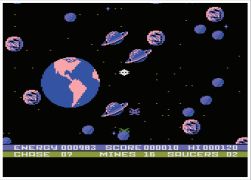
ASTRO CHASE
■ First Star’s debut title was a frantic interstellar battle to save Earth, with the pilot of a saucer-shaped craft eliminating enemy spaceships and the creeping megamines that were targeting it. With impressive cut-scenes and colourful graphics, it was a fun if simplistic blaster with a nice use of simulated physics. A remake, Astro Chase 3D, was also released for the Mac in 1994.
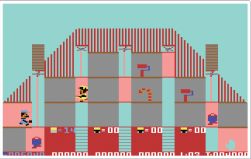 BRISTLES
BRISTLES
■ A light-hearted take on home DIY, Bristles starred an errant decorator on a mission to paint a series of houses while avoiding unlikely hazards (buckets on legs?) and riding elevators, all to a jaunty classical soundtrack. On the way players had to keep an eye out for Brenda the Brat, a teenage upstart who happily left handprints all over your hard work and messed up your paintbrush…
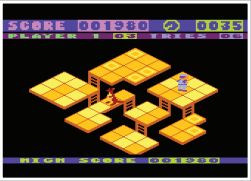 FLIP & FLOP
FLIP & FLOP
■ This isometric action game featured a pair of animal heroes, Flip the Kangaroo and Flop the Monkey, tasked with touching coloured tiles to complete each level while being chased by a zookeeper and his net. Players took turns to control each animal escapee, and while guiding Flip felt much like Q*bert as he hopped over the playfield, Flop was trickier as he hung perilously below it.
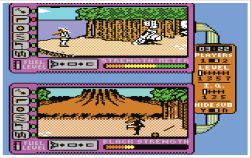 SPY VS SPY II: THE ISLAND CAPER
SPY VS SPY II: THE ISLAND CAPER
■ Generally considered the best of First Star’s Spy Vs Spy trilogy, The Island Caper saw the comical agents from MAD magazine stranded in the Pacific, looking for plans for a top-secret missile. Like the first game it was great fun with two players, as you laid makeshift traps – palm-tree snares, spiked pits and coconut bombs – to outwit your opponent and escape in a friendly submarine.
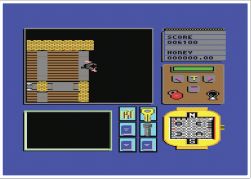 SECURITY ALERT
SECURITY ALERT
■ This less well known First Star release was a clever concoction, the puzzle-action game equivalent of Entrapment. It put you in the shoes of a would-be cat burglar trying to rob a series of buildings while avoiding alarms, security cameras and robot guards. Starting with a jewellery store heist players worked up to the potential booty offered by a museum, bank and finally an embassy
Thanks to retro GAMER for the permission to publish this article.
https://www.myfavouritemagazines.co.uk/retro-gamer-print-back-issues/
Boulder Dash® and Rockford® are trademarks of BBG Entertainment GmbH, registered in the US, the European Union and other countries. Boulder Dash® 30th Anniversary™, Boulder Dash® Deluxe™, Boulder Dash® 40th Anniversary™, Crystal™ and Goldford™ are trademarks of BBG Entertainment GmbH. Copyright © 1984-2025 BBG Entertainment GmbH. All rights reserved. The original Boulder Dash® was created by Peter Liepa with Chris Gray.